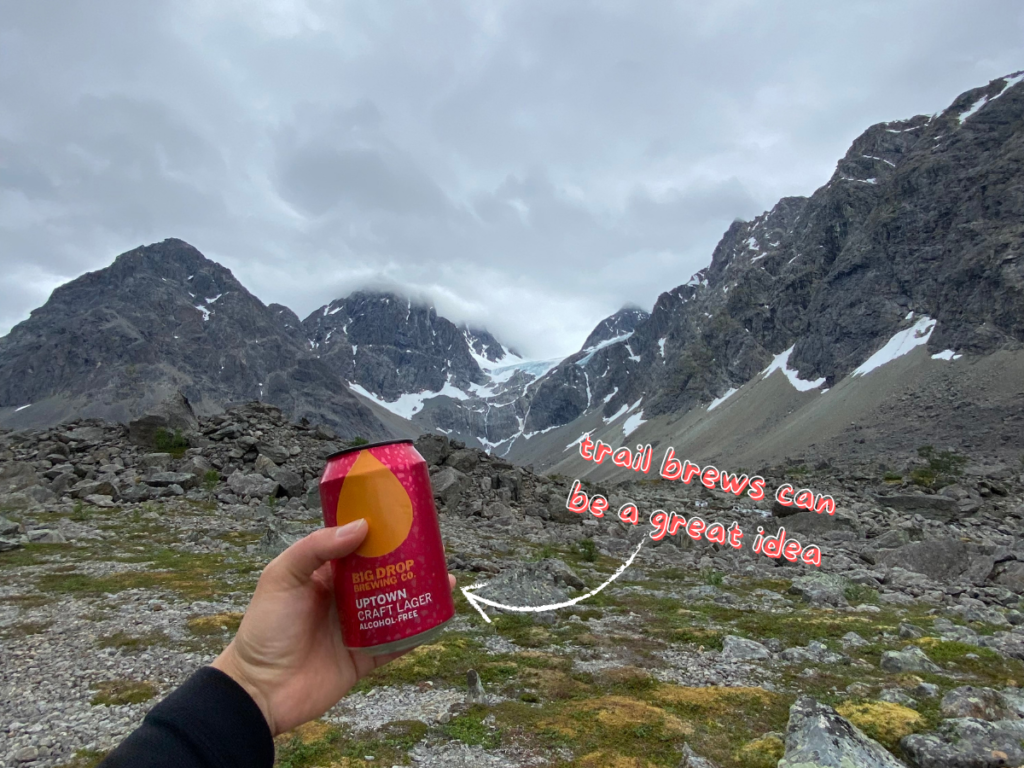
Hiking Essentials:
Hiking Backpack: On my overnight camping adventures, I pack all my essentials (and some optionals) into a 55L Osprey pack. For me, it’s a great size to fit everything in and still remain comfortable enough to carry.
Rain bag cover: Sometimes, this is something often overlooked. Now, if you’re camping somewhere with perfect sunny weather, you might not be needing this. But if you’re hiking somewhere where the weather is a bit more temperamental, you probably want this. The last thing you want after a long day of hiking is wet gear!
Dry Bag: In the same breath, because the weather is so unpredictable in Norway, I have packed some gear into a dry bag – especially sleeping bag and spare clothes, electronics and fire starters. You never know with the weather some days!
Hiking poles: Love them or hate them. I personally enjoy using hiking poles. They help give me that extra balance on unstable ground. But also very helpful when I’m on the incline to give me that constant movement or assistance when I’m knackered.
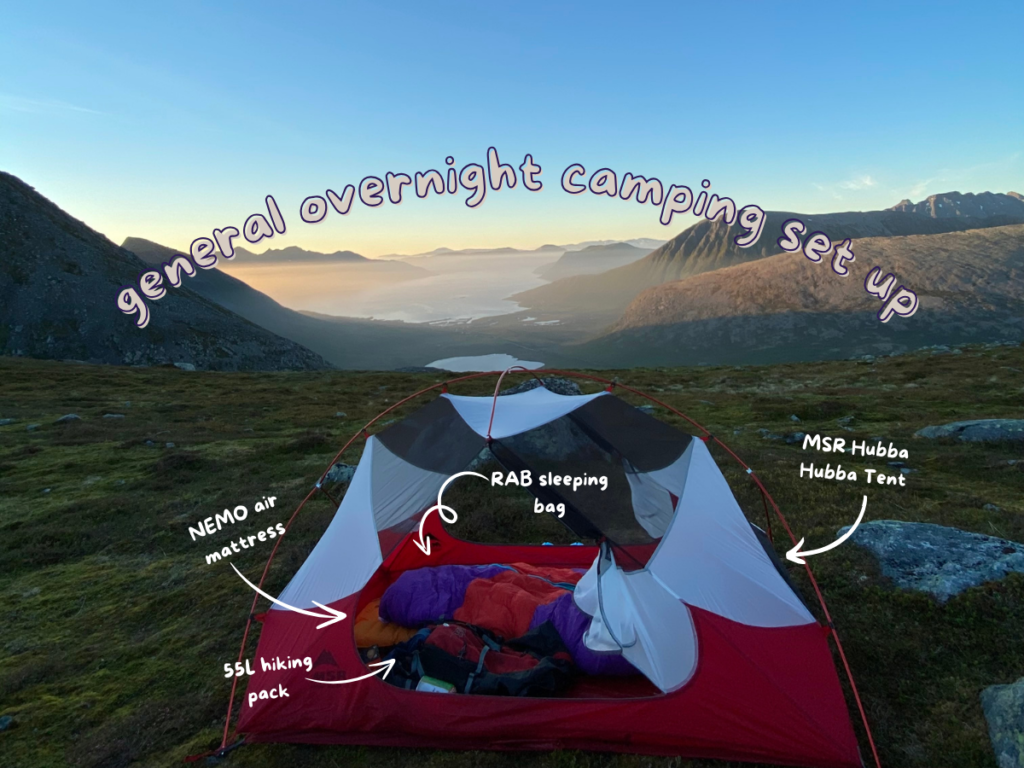
Shelter and Sleeping Systems:
Tent: Requirements are usually a sturdy, weather resistant tent with enough space for you/your group. If you’re going backcountry, you’d want something lightweight. My go-to has been the MSR Hubba Hubba (2 person) tent with a ground fly for either solo or couple adventures. It is on the pricier side but a personal favourite.
Sleeping Bags: Where/when are you camping? Biggest factor is what the expected temperatures. Norway runs chillier at night so I carry a 3 season sleeping bag. My trusty sleeping bag of over 5+ years has been the RAB Morpheus (W) sleeping bag rated to comfort of 0 deg. I pair this with a silk sleeping bag lining to keep the internal of my sleeping bag cleaner for longer.
Sleeping Pads/Air Mattresses: Get off the ground! Sleeping on it is uncomfortable but also cold. Sleep systems elevate your body off the ground, keeping yourself warmer. There is no “wrong” sleeping system. Personally, air mattresses more comfortable compared to a sleeping pad. I carry a NEMO Cosmo (3.3 R rating) with a built in foot pump built. Of course if you’re camping in the colder months, look at stacking your sleep systems to increase the R-value of your set up.
The R-value in a sleep system is essentially the rating against colder terrain.
Optional:
Camping Pillow: This is optional because of the extra weight but honestly, it is worth it for me. Part of my creature comforts and secrets to a good nights sleep while outdoors. I bought a cheap inflatable one from my local sports shop that packs really small and I pack it with my sleeping bag. It’s so small that I barely realize it’s there.
Eye mask: I don’t usually sleep with an eye mask, I don’t actually enjoy to. However, when you’re camping somewhere where the midnight sun happens, you might wish you had packed it!
Cooking System:
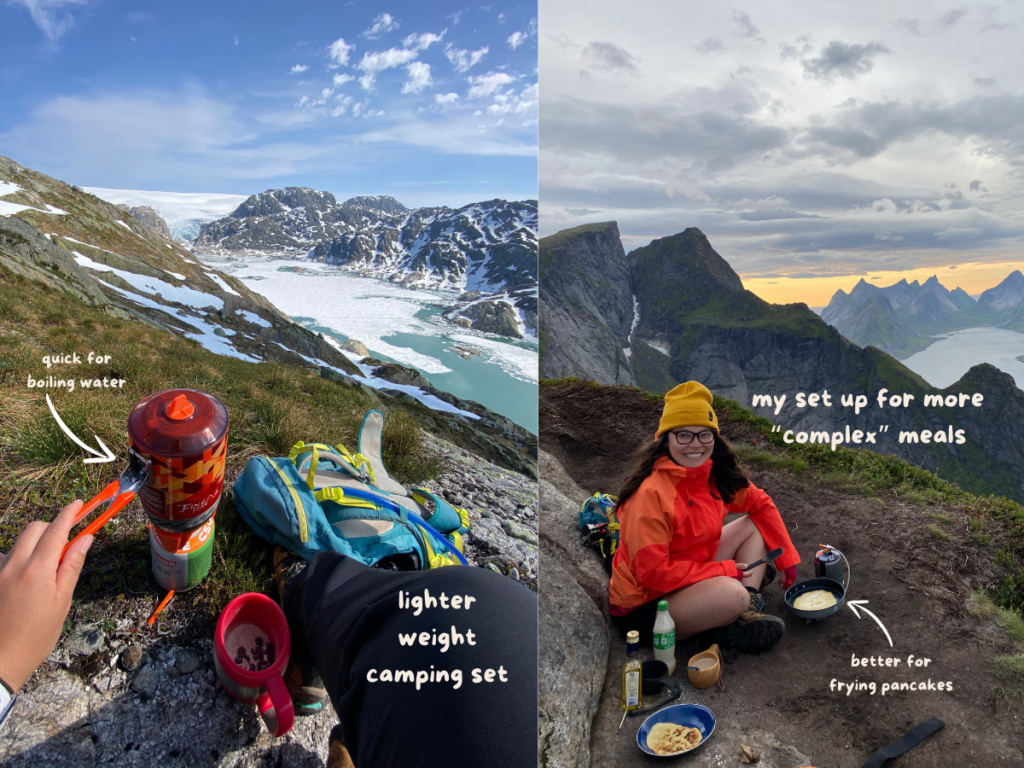
Hydration: You could definitely utilize any water bottle and store it on the side of your pack. Alternatively, you could invest in a hydration bladder/camel pack with a drinking nozzle on your backpack strap for easy access.
Camp Stove: This is probably one of the most important pieces of gear. Invest in a reliable camp stove for cooking delicious meals outdoors. Usually a stove top that is connected to your portable gas tank.
Cooking Utensils: For backcountry trips, pack lightweight cooking utensils, pots, and pans for preparing meals.
I recently upgraded from a “heavy set up” which had a pot, frying pan, kettle and a foldable plate, plastic utensils to a bit more of an “all inclusive” set up. I love my initial set up but it was starting to get pretty heavy. My FireMaple set up is perfect for boiling water for coffees, rehydratable meals or soups, might not be great if you’re planning on making a fry up at camp!
Non-Perishable Food: Stock up on canned goods, dry snacks, and instant meals for easy to reach/cook meals on the trail. Dry snacks that I pack are various flavors of muesli, mixed nuts and powder coffee.
Optional/Car Camping
Portable Stove: Pack a lightweight stove for cooking meals on the go.
Cookware Set: A proper set of pots, pans, and utensils for making more elaborate meals.
Cooler: Keep food fresh with a reliable cooler or icebox.
Water Filtration System: Depends on your access to clean drinking water. You can use portable filtration systems or purification tables.
Lighting and Navigation Tools:
Headlamp or Flashlight: Illuminate your campsite and navigate nighttime adventures with a bright headlamp or flashlight. Consider options with adjustable brightness settings and long battery life.
Camp Light: While flashlights are great to be used navigating around, I find the best way to illuminate camp is by using a camp light. It converts from a compact flashlight to a camp light with an easy twist and pull.
Map and Compass: Stay on track and explore off-the-beaten-path destinations with a reliable map and compass. Familiarize yourself with navigation techniques for added safety.
Outdoor Apparel:
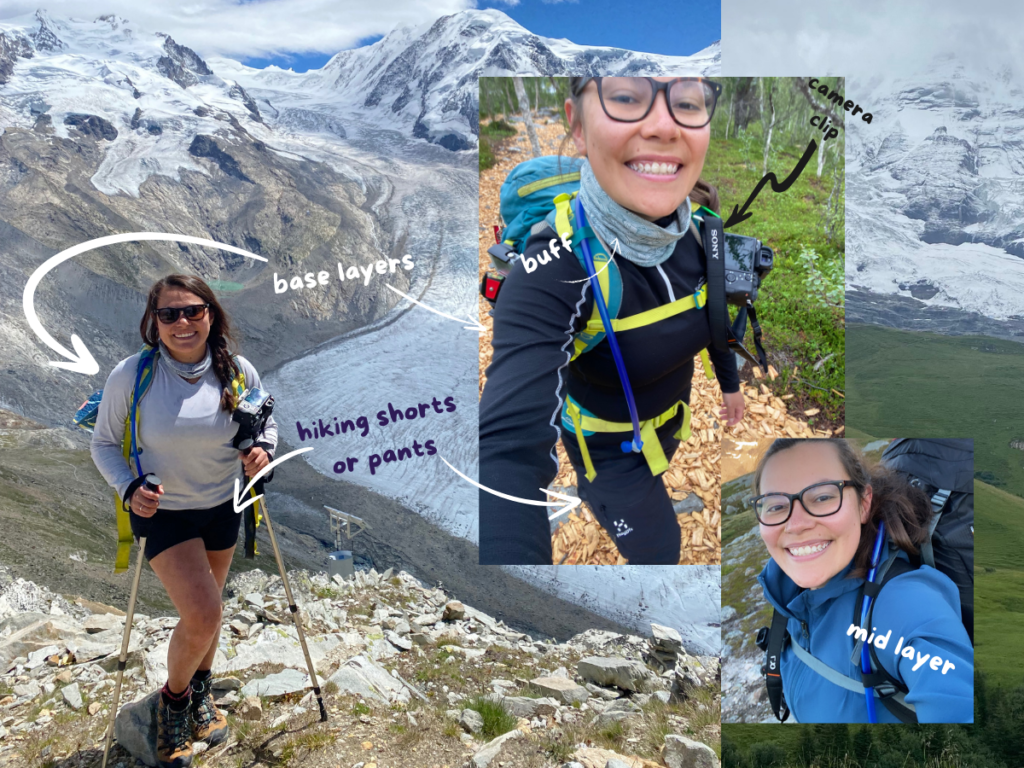
Outdoor apparel is very personal in terms of where you are hiking, the altitudes, weather forecast/conditions and most importantly, what works best for you. Ideally, you want to pack versatile clothing layers suitable for changing weather conditions. Include moisture-wicking base layers, insulating mid-layers, and waterproof outer layers.
Base layer: The layer closest to the skin. For the warmer temperatures, I like wearing a sports top or a quick drying shirt – long sleeve if it is super warm so it doubles as sun protection. For the cooler temperatures, I wear merino wool long sleeves or t shirts – they are quick drying, light weight, compact and very warm.
Mid layer: This usually comes as a fleece or jumper. Something to wear continuously if the temperature is cooler. Depending on the time of year, this can look like a long sleeve windbreaker, thick enough to retain heat but not so thick that it’s unbearable.
Outer layer: I use a puffer for this. This comes on usually at camp or during the breaks if it is in an exposed area.
Waterproof layer: The rain can be so unpredictable, sometimes there’s really strong winds. I invest in a good waterproof layer that I maintain yearly. My most common two layers are by Bergens of Norway and Twenty Four.
Hiking Pants or shorts: Personally it is weather dependent. If the forecast is really warm, I will wear athletic shorts and bring my hiking pants for when the temperature drops overnight.
Pajamas: Probably not what you were expecting on this list? Even when I’m backcountry, I had a spare thermal top and bottom to change into at camp or for bed. This is a personal choice as I prefer not to sleep in my sweaty clothes and having a dry pair of clothes I find helps me retain my heat instead of loosing it when my clothes are damp and warming myself back up.
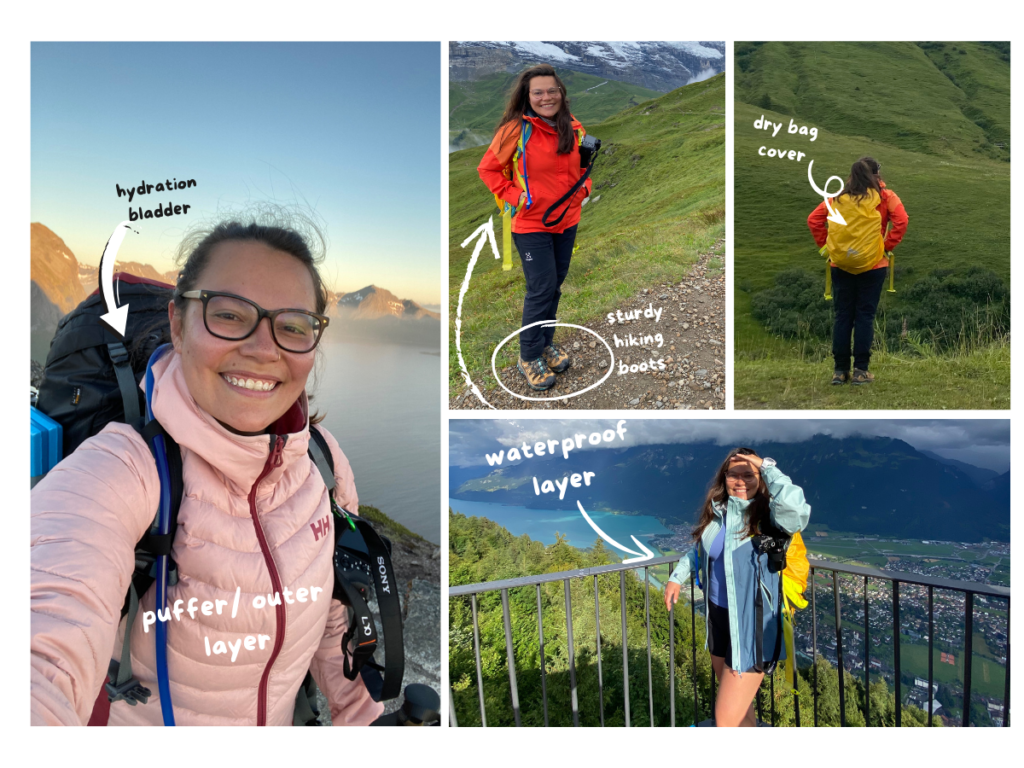
Footwear:
Sturdy Footwear: This can come in different styles. Hiking/mountain boots for added ankle support. Trail runners for lightweight options. Overall you want to evaluate the type of terrain you will be exposed to and ensure proper fit + ankle support for longer hikes and uneven terrain.
Wool socks: Depending on where I am hiking, some days I prefer wearing high cotton socks and some other days, I prefer wearing wool socks for extra warmth.
Camp footwear: After a long day of hiking, the best feeling is taking off your shoes and slipping your feet into something a lot more comfortable. My weapon of choice is my knock off Birkenstocks with a pair of woolen socks.
Safety and Emergency Gear:
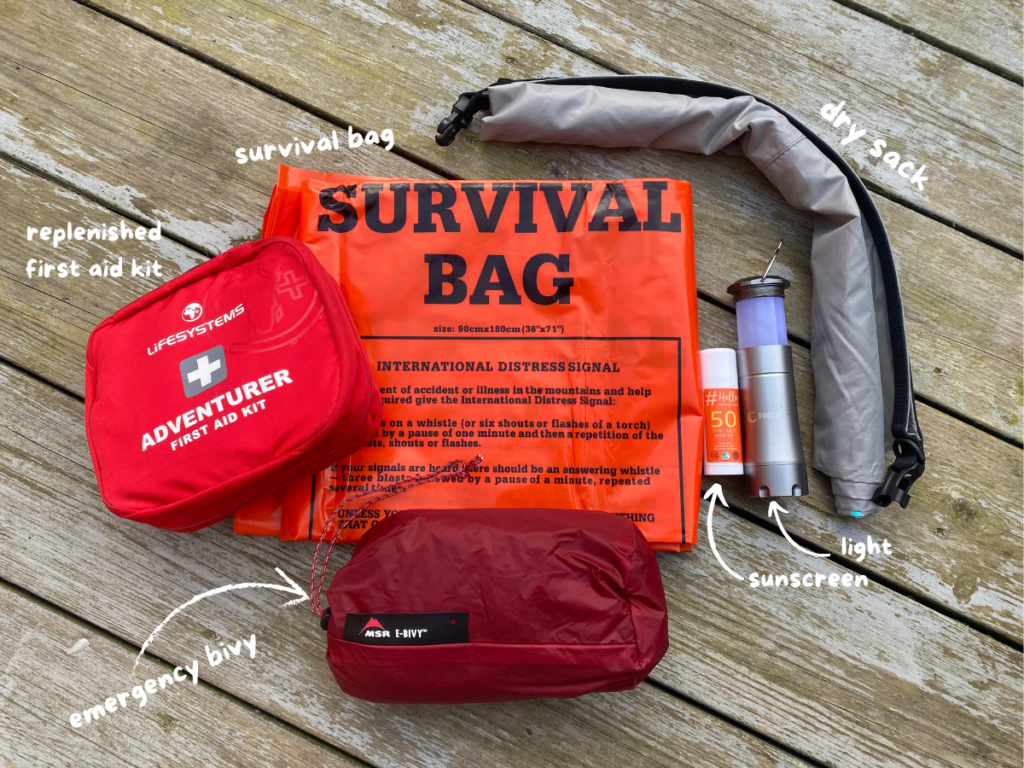
First Aid Kit: Be prepared for minor injuries and medical emergencies with a well-stocked first aid kit. Include essentials like bandages, antiseptic wipes, pain relievers, and emergency medications.
Emergency Shelter/e-Bivy: Pack a lightweight emergency shelter, such as a space blanket or bivy sack, for unexpected situations.
Fire Starter: Bring waterproof matches, a lighter, or a fire starter tool to ignite campfires safely. Familiarize yourself with fire regulations and local restrictions.
Multi-Tool: A versatile tool with features like a knife, scissors, and screwdriver.
Survival Bag: It is similar to a e-bivy in the sense that it will keep you protected from the elements in an emergency. If you join an outdoor first aid course, they will teach you how it can be used in other scenarios – ie. a makeshift stretcher.
Emergency Communication: Carry a charged cell phone or two-way radio for emergencies.
Optionals:
Battery pack: I would argue this isn’t necessarily an optional but a necessity. The issue with some of these is that they can be bulky and heavy. But you never know when you’re in the backcountry with a phone that’s low on juice.
Camping Comfort and Entertainment (all optional)
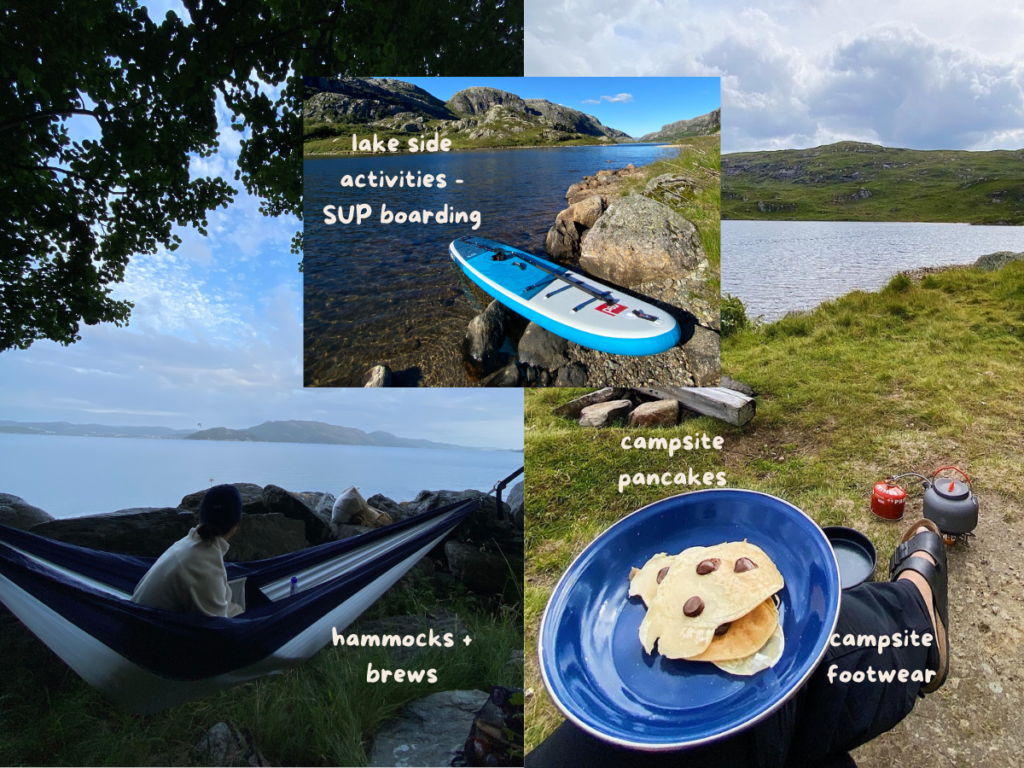
Sheep skin: In the winter or colder weather, one of my camping essentials is actually sheep skin that I sit on or lay beneath me. It’s an extra layer of insulation to the cold ground.
Hammock: Relax and unwind in nature with a lightweight camping hammock.
Camera: Capture memories of your outdoor adventures with a waterproof camera or smartphone.
Camera Clip: If you’re like me and you need easy access to your camera, my best investment has been my PeakDesign camera clip that is strapped on my shoulder pad, giving me super easy and convenient access to my camera when I need it without having to take my pack off.
Camp Mat: I am one of those that enjoys seating on the ground but sometimes it is a bit uncomfortable sitting directly on the damp ground. While car camping or road tripping, I pack a rattan mat and place that in front of my tent. It makes for a great spot to sit outside of the tent but also a good entrance mat for the tent to take off shoes before entering.
Journal: Document your experiences and reflections in a travel journal or notebook.
Entertainment: Enhance your camping experience with entertainment options like books, board games, or musical instruments. Embrace the opportunity to disconnect and enjoy quality time in nature.
Portable Speaker: Enjoy music or podcasts with a compact Bluetooth speaker. But remember that no one else wants to listen to your music so keep the volume low especially if it is a shared campsite.
Collapsible Gear: These tend be be more expensive but you can save space with collapsible cooking utensils, bowls, and water bottles.
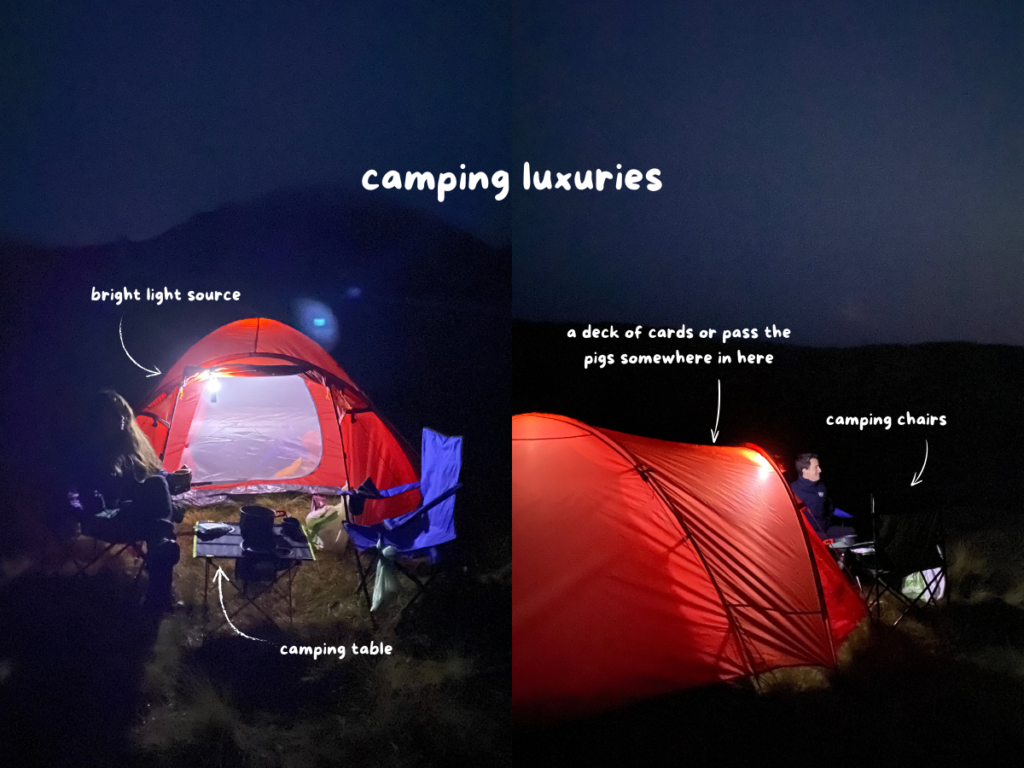
Optional while car camping
Camp Chairs: Relax and unwind around the campfire with comfortable folding camp chairs. Look for lightweight and compact designs for easy transportation.
Camp Table: When I am car camping, this is such a nice luxury to have. It’s an even and great platform to cook on, play games, set up.
Solar Charger: Keep electronic devices powered up with a solar charger or power bank.
Portable Shower: Stay fresh on extended trips with a portable camping shower.
Campsite Organizer: Keep gear organized and accessible with a hanging campsite organizer.
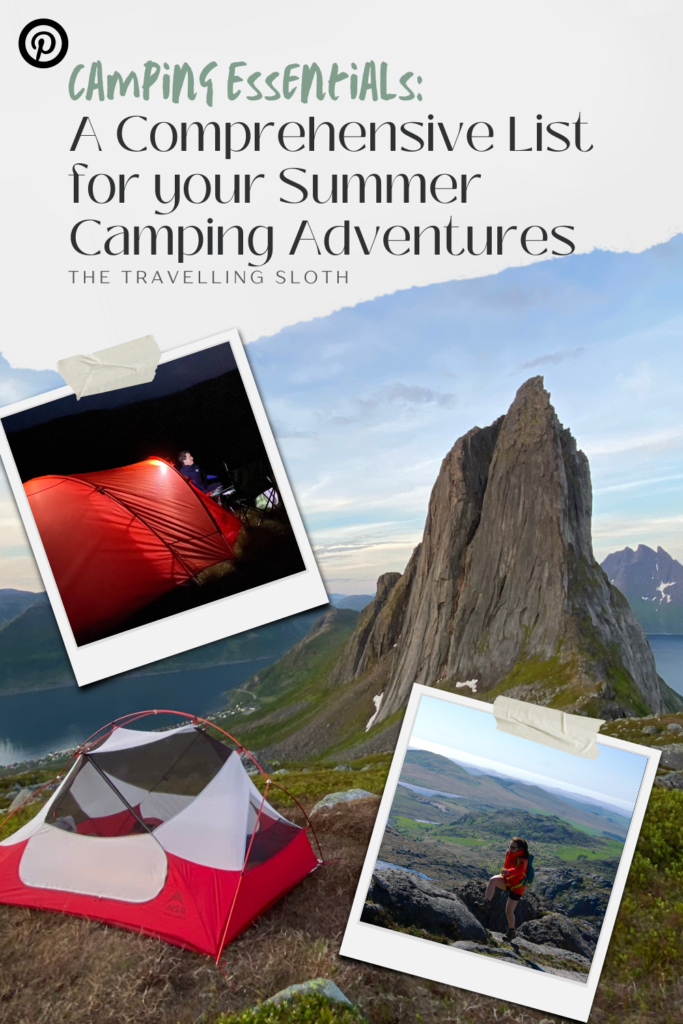
With the right gear and preparation, your camping road trip or outdoor adventure is bound to be a memorable experience. From cozy nights under the stars to thrilling hikes through scenic landscapes, embrace the freedom of camping and immerse yourself in nature’s beauty. Gear up, hit the road, and let the adventure begin!
Did I miss anything? What are some of your camping gear essentials? Let me know down below in the comments! Happy camping.

Leave a Reply